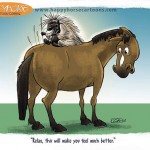
If you have ever owned a horse diagnosed with laminitis, founder, navicular syndrome or any other type of hoof problem you know how devastating it can be. Even with advances in modern technology some horses are still diagnosed incorrectly and inadequately leaving the owner helpless and the horse in pain.
Most diagnosed cases start out with strict regimens of prescription medications including steroids, pain killers and other anti-inflammatory medications. This is then followed by costly farrier bills, stall rest, more vet bills and a horse still in pain.
Preventing hoof problems in a horse is a great stress on a horse owner and with all of the different variables to consider from footing, shoeing, conditioning, diet and nutrition, to genetics, even the best cared for equines on the planet could still be plagued.
So what do you do if your horse is having lameness issues or has been diagnosed with a hoof condition such as navicular? Get your facts and know your options. Prescription medications have long lists of side effects. Prescribing a medication like a steroid to “see how your horse looks” after a certain period may do more harm than good. This is not a good way to try to diagnose a hoof condition and could even make the situation worse.
Continue reading Tip of the Week – Your Horse Has Been Diagnosed with Founder – Call 911 Now!








